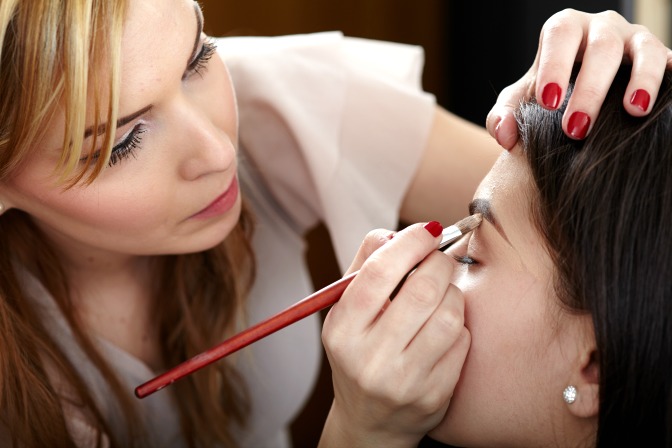Using the same products and techniques on every face might sound nice and easy, but it doesn’t make for flawless makeup. Depending on age, skin type, and undertones, each person’s cosmetic needs are different. For makeup artists, age can be especially tricky to work with. Mature skin has characteristics and needs that other skin does not. Applying products like foundation without taking age into account won’t result in an application that makes your client feel happy and confident.
Professional makeup artists cater their process to their clients’ age. Knowing when to adjust your products and techniques for mature skin can mean the difference between a gorgeous look and one that actually makes your client look older. Strive for a naturally flawless appearance rather than excessive glamor.
Check out these makeup do’s and don’ts for mature skin!
 Don’t use powdered blushes that might cake into fine lines and look creased. Avoid bright colors and very shimmery finishes that will look gaudy or out of place with the rest of your natural palette. For many mature clients, you’ll avoid contouring the cheeks as well, as this can make the face appear hollowed, aging the client further.
Don’t use powdered blushes that might cake into fine lines and look creased. Avoid bright colors and very shimmery finishes that will look gaudy or out of place with the rest of your natural palette. For many mature clients, you’ll avoid contouring the cheeks as well, as this can make the face appear hollowed, aging the client further.
 Don’t use mascara and brow pencils so thickly that the eyes look harsh or out of place against the client’s face. Rather than giving them the youthful, bright appearance your client was hoping for, brows and lashes that are too dark and thick shrink the eyes’ appearance.
Don’t use mascara and brow pencils so thickly that the eyes look harsh or out of place against the client’s face. Rather than giving them the youthful, bright appearance your client was hoping for, brows and lashes that are too dark and thick shrink the eyes’ appearance.
 Many makeup artists, especially new ones, forget to consider the needs of mature skin, making clients over the age of 40 wary of paying for professional makeup applications. If you can build a reputation for working well with mature skin, you might tap into a new market.
Many makeup artists, especially new ones, forget to consider the needs of mature skin, making clients over the age of 40 wary of paying for professional makeup applications. If you can build a reputation for working well with mature skin, you might tap into a new market.
Foundation
Do choose the right foundation. For mature skin, this goes beyond color matching and considering undertones (although this is crucial for covering inconsistencies as well). Moisturizing foundations containing SPF protection and benefit ageing skin without drying it out. They also often have a lighter finish, letting you blend naturally. Look for products that provide enough coverage to mask discoloration and inconsistency in skin tone without looking like a mask. Don’t settle for very thick foundations or loose powder foundations. As the client goes about her day, these products will settle into the creases where her face moves, causing visible lines in the makeup. These lines will enhance the appearance of wrinkles and can actually cause your client to appear older.Blush
Do choose a cream blush that blends smoothly. Stick to warm colors and light satin finishes that give the face a natural, warm glow. Apply blush on the apples of the cheeks, blending very lightly back and up. Concentrating on the rounded area of the cheeks gives the face a fullness that can actually be lost with age. Don’t use powdered blushes that might cake into fine lines and look creased. Avoid bright colors and very shimmery finishes that will look gaudy or out of place with the rest of your natural palette. For many mature clients, you’ll avoid contouring the cheeks as well, as this can make the face appear hollowed, aging the client further.
Don’t use powdered blushes that might cake into fine lines and look creased. Avoid bright colors and very shimmery finishes that will look gaudy or out of place with the rest of your natural palette. For many mature clients, you’ll avoid contouring the cheeks as well, as this can make the face appear hollowed, aging the client further.
Eye makeup
Do use neutral tones on the lids to emphasize eye color and shape. Choose shadows with a light satin finish that will brighten the eyes without looking garish. Make sure the tones you choose suit the client’s skin tone and coloring. Don’t use shadows that have either a very matte or very sparkly finish. These settle into fine lines on the lids and become creased. Also, using very dark colors on the eyes can overshadow the rest of the features and emphasize hollowness or inconsistency in skin tone. Do pay attention to eyebrows and eyelashes. These features tend to thin out and lighten with age, giving the eyes a naked, shrunken appearance in the most faded cases. Use a light brow pencil that suits the client’s hair color to revive the brows’ color. Follow the natural shape of the brow and blend the color lightly so the brows don’t appear drawn on and harsh at the edges. Black mascara is appropriate to give the lashes body for most mature clients, but consider brown or gray mascara if your client’s hair is very light, white, or grey. Don’t use mascara and brow pencils so thickly that the eyes look harsh or out of place against the client’s face. Rather than giving them the youthful, bright appearance your client was hoping for, brows and lashes that are too dark and thick shrink the eyes’ appearance.
Don’t use mascara and brow pencils so thickly that the eyes look harsh or out of place against the client’s face. Rather than giving them the youthful, bright appearance your client was hoping for, brows and lashes that are too dark and thick shrink the eyes’ appearance.
Lips
Do use sheer, moisturizing lipsticks. These provide a bit of color and keep the lips looking smooth and full, fighting their tendency to thin out with age. Stick to neutral shades like natural pink or taupe tones that emphasize the color of the lips and suit the skin tone. Lip liner can give the lips a fuller appearance as well. Choose a light tone that suits the skin and the lipstick shade, and over-line the lips very slightly. Rather than applying the liner inside the natural edge of the lip, trace just outside it for a small boost in volume. Don’t use lipsticks that are very bright or dark, and avoid matte finishes. These look dried out and the color settles into lines on the lips, making them appear thin and wrinkled. At the same time, using a lip color that is too glossy, shiny, or shimmery just makes the lips look wet rather than full. When you apply liner, don’t get carried away with your over-lining. You want to counteract thin lips without making your client look like a cartoon character. Stay light handed with liners so they blend well between the skin and the lips, rather than looking like a dark, harsh line.Other helpful hints
Do prime the skin. Applying a quality primer before your base fills some of the finest lines and wrinkles in the skin for a more consistent foundation coverage. Primers even out the surface of the face to prevent creasing. Priming the eyelids before you apply shadow reduces creasing there as well. Don’t use colors that are too bright, dark, or harsh looking. These can make the eyes look sunken, the cheeks to look hollowed, and the lips to emphasize inconsistencies in skin tone. Bonus tip: Absolutely do recommend that your clients maintain a good skincare routine. This should involve moisturizer to increase the skin’s elasticity and SPF to protect it from sun damage. If a client neglects their skin, achieving a flattering makeup application can be difficult no matter how carefully and naturally you apply. Keeping the skin healthy and moisturized reduces the appearance of fine lines and wrinkles that crease makeup and age the client’s face. The best thing you can do for clients with mature skin is to practice before you start charging. You want to make sure that your skills with mature skin are worth your clients’ money and that you’re really helping them look their best. Perfecting your ability to work with skin of all ages and types diversifies your skills and might even increase demand for your services. Many makeup artists, especially new ones, forget to consider the needs of mature skin, making clients over the age of 40 wary of paying for professional makeup applications. If you can build a reputation for working well with mature skin, you might tap into a new market.
Many makeup artists, especially new ones, forget to consider the needs of mature skin, making clients over the age of 40 wary of paying for professional makeup applications. If you can build a reputation for working well with mature skin, you might tap into a new market.

What brand foundations would you recommend for Mature skin.
I am 64 . I use Juice Beauty SPF30 Tinted Moisturizer BB as a foundation and their Phyto-Pigment cream concealer where needed. I also use their primer before applying the tinted moisturizer. This works for me.
LOVE THIS
i remember loving the time i spent putting on my makeup,, but now, it makes me weep. masks against covid are my go-to face fix!!
Hi Jan, thanks so much for taking the time to read and comment. We’re so sorry to hear that makeup doing bring as much joy as it used to. We’re sending you all the virtual internet hugs! With the right tips and tricks, though, you can learn how to apply makeup to mature skin and hopefully reinvigorate that love you used to have for it! <3
All the best,
Sarah
The QC Team